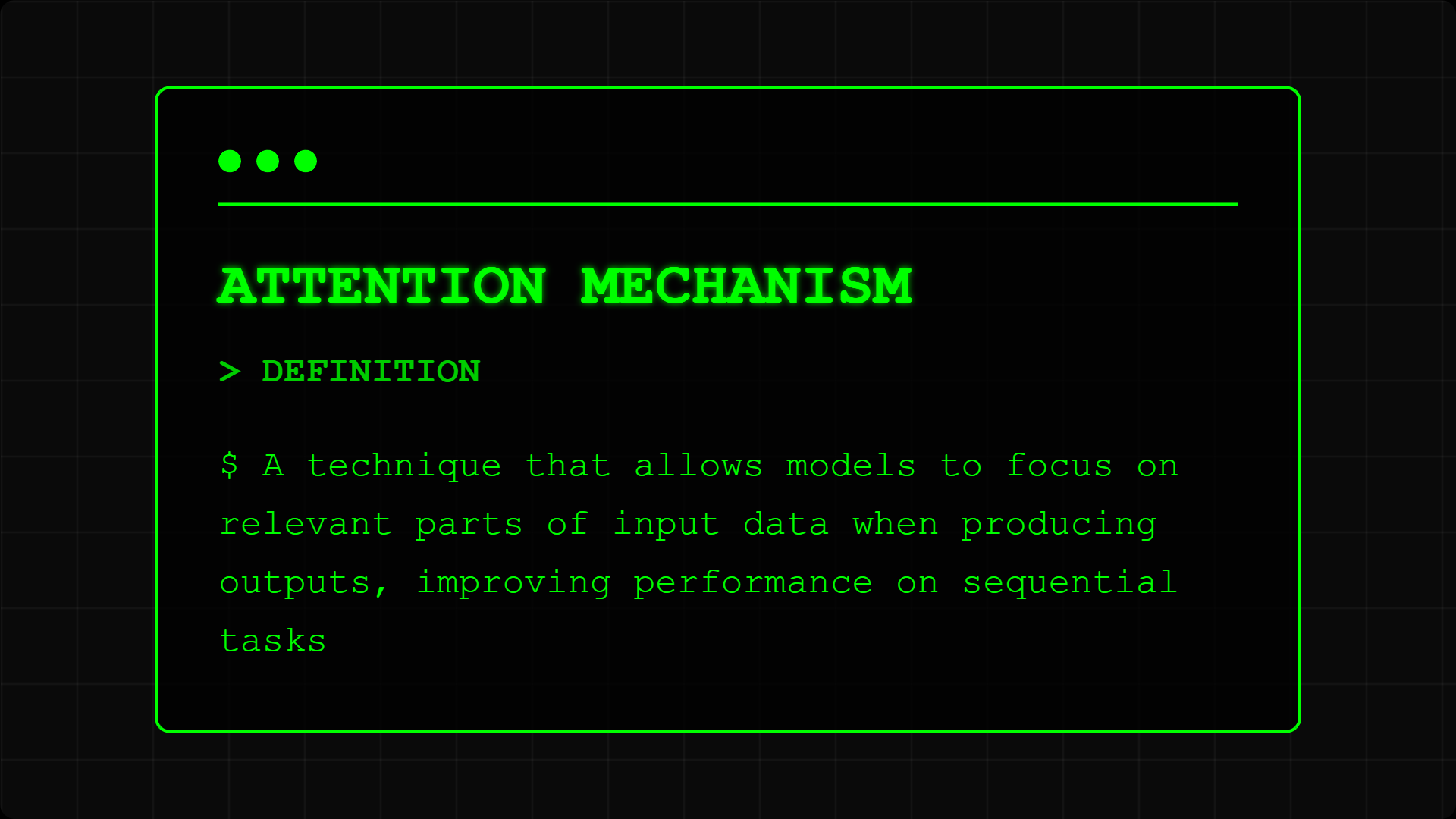AI Terms
What is Attention Mechanism? Teaching AI Where to Look

When you read a contract, you don't give equal weight to every word – you focus on key terms, obligations, and deadlines. The attention mechanism gives AI this same ability, revolutionizing how machines understand language by learning what deserves focus. It's the secret sauce behind AI's dramatic improvements.
Technical Foundation
Attention mechanism is a technique in neural networks that allows models to dynamically focus on different parts of the input when producing each part of the output. Instead of compressing all information into a fixed representation, attention creates weighted connections between all positions.
The breakthrough paper "Neural Machine Translation by Jointly Learning to Align and Translate" (2014) introduced attention, stating: "The attention mechanism allows the model to automatically search for parts of a source sentence that are relevant to predicting a target word."
Mathematically, attention computes relevance scores between elements, converts them to weights through softmax, then creates weighted combinations – essentially learning what to "pay attention to."
Business Understanding
For business leaders, attention mechanism is like giving AI a highlighter and teaching it what to mark – it identifies and focuses on the most relevant information for each decision, dramatically improving accuracy and explainability.
Imagine analyzing customer feedback where one sentence praises service but another mentions a critical product flaw. Attention helps AI recognize that the complaint deserves more weight when assessing satisfaction, just as a human analyst would.
In practical terms, attention enables chatbots that track conversation context, document analyzers that find key clauses, and recommendation systems that understand which user behaviors matter most.
How Attention Works
The attention process step-by-step:
• Query Formation: For each output position, create a "query" representing what information is needed
• Relevance Scoring: Compare this query against all input positions to calculate relevance scores
• Weight Calculation: Convert scores to probabilities using softmax – high scores get high weights
• Weighted Combination: Multiply each input by its attention weight and sum to create context-aware representation
• Output Generation: Use this focused representation to generate output, whether translation, summary, or response
Types of Attention
Different attention mechanisms for different needs:
Type 1: Self-Attention Focus: Elements attend to each other Use case: Understanding relationships within text Example: Pronoun resolution, document coherence
Type 2: Cross-Attention Focus: One sequence attends to another Use case: Translation, question answering Example: Aligning English to French words
Type 3: Multi-Head Attention Focus: Multiple attention patterns in parallel Use case: Capturing different relationship types Example: Syntax and semantics simultaneously
Type 4: Sparse Attention Focus: Attend only to relevant positions Use case: Long document processing Example: Focusing on nearby context
Attention in Action
Real-world applications demonstrating value:
Translation Example: Google Translate's attention mechanism knows to focus on "nicht" in German when translating "not" in English, handling word order differences that previously caused errors, improving translation quality by 60%.
Customer Service Example: Salesforce's Einstein uses attention to track which parts of previous messages matter for current responses, enabling chatbots that maintain context across long conversations with 85% accuracy.
Document Analysis Example: DocuSign's AI uses attention to identify signature blocks, dates, and key terms across varied document formats, focusing on legally significant sections while ignoring boilerplate text.
Visual Understanding
How attention makes AI interpretable:
Attention Visualization:
- Heat maps showing which words AI focused on
- Debugging tools for model behavior
- Explainability for stakeholders
- Trust building through transparency
Example: In sentiment analysis of "The food was terrible but the service was excellent," attention weights show the model focusing on "terrible" and "excellent" while downweighting "was" and "the."
Business Benefits
Why attention matters for applications:
Improved Accuracy:
- Better context understanding
- Reduced errors in complex tasks
- Handling of long-range dependencies
- Nuanced decision making
Enhanced Explainability:
- See what AI considers important
- Debug unexpected behaviors
- Build user trust
- Meet regulatory requirements
Efficiency Gains:
- Focus computational resources
- Faster processing of relevant info
- Reduced model size needs
- Better scaling properties
Attention Applications
Where attention excels:
Document Processing:
- Contract key term extraction
- Report summarization
- Email prioritization
- Compliance checking
Conversational AI:
- Context tracking in dialogues
- Intent understanding
- Response relevance
- Multi-turn reasoning
Recommendation Systems:
- User behavior analysis
- Content matching
- Temporal patterns
- Feature importance
Time Series Analysis:
- Stock pattern recognition
- Anomaly detection
- Demand forecasting
- Sensor data interpretation
Implementation Considerations
Key factors for success:
• Computational Cost: Attention can be expensive for long sequences → Solution: Efficient attention variants like Linformer
• Interpretability Balance: Too many attention heads complicate interpretation → Solution: Attention head pruning
• Domain Adaptation: Generic attention may miss domain patterns → Solution: Fine-tuning on specific data
• Memory Requirements: Storing attention matrices → Solution: Gradient checkpointing, attention approximation
The Future of Attention
Emerging developments:
- Attention for video understanding
- Cross-modal attention (text-image)
- Biological sequence modeling
- Efficient attention for edge devices
- Learned attention patterns
Mastering Attention
Your path to attention-powered AI:
- See attention enabling Transformer Architecture
- Understand Self-Attention specifically
- Explore Explainable AI through attention
- Read our Attention Mechanism Guide
FAQ Section
Frequently Asked Questions about Attention Mechanism
Part of the [AI Terms Collection]. Last updated: 2025-01-11